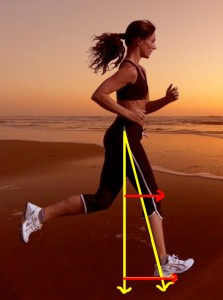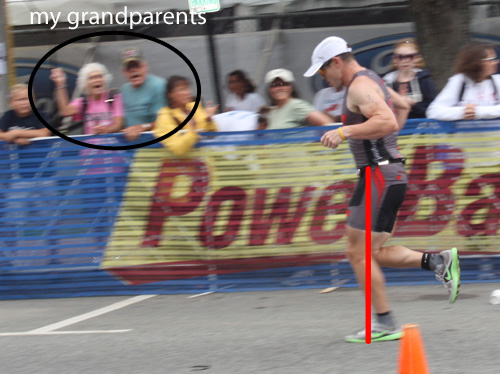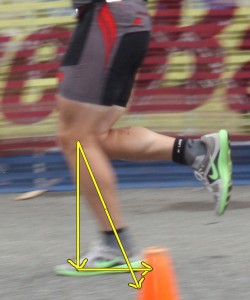There are very few topics in the sport performance world that I feel compelled to debate until they put me into the ground. However, the topic of running mechanics is one that gets me fired up. I’ve been through endless running and biomechanics related continuing education courses, and have had the pleasure to pick the brains of several great running minds including Olympic track and field coach Loren Seagrave. But even through all of this, it is funny to me that my high school and college physics classes (I almost majored in physics) are what drive a large part of my argument as to what is the “correct” way to run. I am a numbers guy, but I will spare you the endless research references and just stick to the science based facts and the laws of physics.
As a triathlon coach, I would never look at someone flopping around in the water like a dying fish and say “well we just need to work with their natural swim stroke.” Swimming is the most technically demanding endurance sport there is. Having an effective and efficient swim stroke takes lots of time and effort. Running is no different. Having an effective and efficient running gait takes a lot of time and effort. So why are there people out there still arguing that you should not try to get someone to change their “natural” running style? I put “natural” in quotes because these days, natural stems from years of doing a lot of walking and not a lot of strenuous physical activity.
Going back to the swimming example. We all know that in order to become more efficient in the water, there is a good chance that you will end up slowing down for a bit while you learn correct mechanics and body positioning. But, as you become more efficient, you eventually speed right back up to where you started or beyond, but with a lesser energy expenditure. Again, running is no different. Learning to change any motor pattern, especially in older athletes, is difficult and takes persistent consistent effort to make a permanent change.
The people I aim to call out here are the hardcore frontside heel strikers. This is when the heel is the first thing that makes contact with the ground and the foot makes full touch down out in front of the runner’s hips (Center of Mass). I won’t make a hard sales pitch to these folks on midsole running until the next installment. We will go one step at a time. Pun fully intended.
There are a number of different schools of thought on proper running mechanics. Between them all, there are three big commonalities that boast the greatest benefits to runners. In no particular order they are: Reduced Impact, Elastic Recoil, and Reduced Energy Expenditure. These my friends, are the reasons why you (if you haven’t already) should consider ditching your antiquated running style.
So what is “correct”? Let’s take this in light of what makes the most sense. Since I quickly realized how long this blog would be if I explained all three at once, I am going to touch on these three topics one at a time. Surely leaving you on the edge of your seat, begging for the next Installment. The first item on the list is Reducing Impact.
IMPACT. Let’s face it, running is tough. Especially running long. Muscle vibrations due to ground impact forces are one of the the leading causes of muscle fatigue while running. The “wall” everyone refers to during a marathon usually comes from tiny tears in the muscles due to ground impact forces. You know when you feel like you are running on wooden stumps? Not fun. If it were a nutritional issue we would call that a “bonk.” A little endurance lingo 101.
Anyways, now for the physics lesson. During a heel strike mechanic, the foot usually contacts the ground out in front of the center of mass (hips). For any force that is at an acute angle in relation to the ground, there are always 2 components of that force. In this case, there is a force at an angle traveling a straight line from the runners hip through their ankle. Then there is a component of that force that is the result of gravity pulling us down that travels through the center of mass, and one from forward motion. So when we actually make contact with the ground a few things happen. One, due to Newton’s third law, there is an equal and opposite reaction right? Well that means that the ground opposes all of those force vectors that we just created. The opposing gravitational force pushes us up…not too bad. The opposing forward force pushes us backward….WAIT! BACKWARD! Yes, the ground is pushing you backward when you land out in front of your hips, thus robbing you of some of that forward momentum you worked so hard to create. In the speed development world, we call this front side contact and is often referred to as SPEED ENEMY #1. Moving on, the resultant angled force down the leg gets both backward and upward force, focused at the ankle, knee and hip joints. In biomechanics we call this a shearing force. This might not be so bad if we had a single bone in our leg and no joints. But we don’t, so the knee joint takes the bulk of the shearing forces. Why? Well an object in motion will stay in motion unless acted upon by an outside force. So when the ground is pushing back on our foot and tibia, the forward momentum at the femur wants to stay on its path, which is forward and down towards the ground. Just think about that for a second. Picture your femur trying to stay in forward motion as your tibia is forced backward by the ground. Now picture that every stride you take. Got knee pain? The other downside to contacting out in front of the body is that the leg lands almost fully extended, which does not dissipate much impact force at all, sending more shearing forces to the hips and more fatiguing vibrations through the muscles.
On the other hand, those that adopt a foot landing position under the hips see much different force distribution. So instead of creating speed stealing shearing forces, we create compression forces. What are compression forces? Compression forces are basically any forces that push us straight up or down. Why is that better? Our skeletal system is made to handle plenty of compression forces. When you stand in one spot, you are being compressed by gravity. I often use the example of standing on a soda can. We have all stood on top of a soda can once in our life. You notice that the thin aluminum structure can withstand your body weight as long as no lateral force is applied to the can. If the can takes on a lateral force…CRUNCH! Our bones are similar in that they can handle FAR more compression forces than the combination of compression and lateral forces simultaneously, previously dubbed shearing forces. Another example are the columns that hold up hundreds of tons on a bridge.
Now you may also notice from the picture that bringing the foot under the hip causes the runner to land with the leg slightly bent. This does a couple of very important things. One, it delegates some of the impact from the knee joint and quads to the hips and glutes. These are stronger muscles that can take a little more beating. The other thing it does is it actually allows the muscles to store the energy from the impact and use it to propel the runner forward. More on that in Volumes 2 and 3.
Going back to the resultant vectors of ground impact, you’ll notice the difference in the direction of force applied to the ground as compared to the frontside heel striker. The Bareminchisole runner applies force backward and downward, which results in the ground causing upward and forward forces. We do want to go forward right? That’s what I thought. The angle of the shin in relation to the ground determines the amount of force that is directed forward. So the deeper the shin angle upon ground contact and take off, the more force we are directing forward. The more force we direct forward, the longer our stride gets. Thus, we go faster.
In short, it all boils down to the direction of the force and leg extension upon ground contact. If you are out in front of the center of mass with an extended leg, the ground resists your forward motion, and there is no shock absorption, thus causing lots of muscle vibrations and shearing forces to the knee and hip joints. If ground contact is made under the center of mass with a slightly bent leg, the body undergoes mostly sustainable compression forces, and the opposing forces actually aid in forward motion.
As if IMPACT wasn’t enough to get you fired up, during the next installment, we will talk about Elastic Recoil and the amount of time you can save during ground contact. You will be amazed, surprised, and astonished all at the same time.
If you want to receive other free training articles, tips and tricks, don’t forget to sign up for our Performance Newsletter. Until next time.
~Dale



